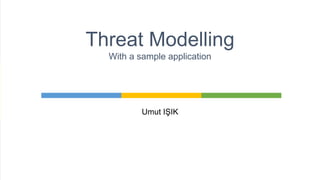
Threat modelling with_sample_application
- 1. Umut IŞIK Threat Modelling With a sample application
- 2. 1. Threat Modelling 2. Sample Application 3. Threat Model Of The Application 4. Resources Table Of Contents
- 3. An approach for analyzing the security of an application Security? ▪ protect applications from external threats ▪ protect data integrity ▪ protect service 1.Threat Modelling
- 4. Vocabulary ▪ Asset; A resource of value such as the data in a database ▪ Threat; Anything that can exploit a vulnerability and obtain, damage, or destroy an asset. ▪ Vulnerability; A weakness or gap in security program that can be exploited by threats to gain unauthorized access to an asset. ▪ Attack (or exploit); An action taken to harm an asset. ▪ Countermeasure; A safeguard that addresses a threat and mitigates risk. 1.Threat Modelling
- 5. The model can be decomposed into three steps 1. Decompose the application 2. Determine and rank threats 3. Determine countermeasures and migitation 1.Threat Modelling
- 6. 1.1. Decompose the application Understanding of the application ▪ External Dependencies ▪ Entry points: sources of input to your application ▪ Assets ▪ Roles: sets of priviledges, trust levels 1.Threat Modelling
- 7. 1.2. Determine and rank threats Categorization of threats (by attackers goal) ▪ Spoofing: Illegal access ▪ Tampering: Maliciously add/modify persistent data ▪ Repudiation: ▪ Information Disclosure: Read data that was not granted ▪ Denial of Service: Make service unavailable ▪ Elevation of Privilege: Gain privileged access 1.Threat Modelling
- 8. 1.2. Determine and rank threats Threats should be ranked according to risk (1-10) (D + R + E + A + D)/5 ▪ Damage; ▪ Reproducibility; ▪ Exploitability; ▪ Affected Users; ▪ Discoverability; 1.Threat Modelling
- 9. 1.2. Determine and rank threats What is risk? Risk = Likelihood X Impact 1.Threat Modelling
- 10. 1.2. Determine and rank threats Likelihood is probability and possibility of the attack. 1. Can an attacker exploit the attack remotely? 2. Is the authentication required? 3. Can it be automated? 1.Threat Modelling
- 11. 1.2. Determine and rank threats Impact is the potential damage and the extent of the damage. Can the attacker 1. take over the system complety? 2. gain administration access to the system? 3. crash the system? 4. access to sensitive information? 1.Threat Modelling
- 12. 1.2. Determine and rank threats Impact is the potential damage and the extent of the damage. 1. How many data sources and components can be impacted? 2. How deep can the threat agent go? 1.Threat Modelling
- 13. 1.3. Determine countermeasures and mitigation Security Controls 1.Threat Modelling Type Security Control Spoofing Authentication, protect secrets, don’t store secrets Tampering Integrity, hash, digital signature, tamper resistant protocols Repudiation Non-Repudiation, digital signature Information Disclosure Confidentiality, privacy enhanced protocols,encryption,protect secrets,don’t store secrets Denial of Service Authentication, authorization, filtering, throttling, quality of service Elevation of privilege Authorization, least priviledge
- 14. 1.3. Determine countermeasures and mitigation Mitigation Strategy 1. Do nothing 2. Inform about the risk 3. Mitigate the risk 4. Accept the risk 5. Transfer the risk 6. Terminate the risk 1.Threat Modelling
- 15. Content Translation Memory (TM) ▪ Memory between internal CMSs to external translation agencies ▪ UI for users to update memory ▪ Service layer for CMS aplications to send and receive data ▪ FTP file transfer to translation agency 2. Sample Application
- 17. 3.1. Decomposing the Application External Dependencies 3. Threat Model Of The Application ID Description Protection Migitation Strategy 1 The application will run on a Linux server running Apache. The server will be hardenned by creating a lates version strategy Transfer the risk 2 The database server will be Mysql The server will be hardenned by creating a lates version strategy Transfer the risk 3 The connection between application and the database Over a private network Terminate the risks
- 18. 3.1. Decomposing the Application Entry Points 3. Threat Model Of The Application ID Name Description Trust Level/Role Migitation Strategy 1 User Interface: • Login Page • Edit Translation • Edit Transaction • Reports All Pages should be accessible via TLS Anonymous User, User with valid credentials Migitate the risk 2 Service Layer All services should be accessible via TLS Service User with valid API key Migitate the risk 3 FTP connection Connect to an external FTP server via TLS User with valid credentials Migitate the risk
- 19. 3.1. Decomposing the Application Assets 3. Threat Model Of The Application ID Name Description Trust Level/Role 1 Content Content data User with valid credentials, Service User with valid API key 2 User data usernames, passwords User with valid credentials 3 Transaction information Locale assignment, translation status User with valid credentials
- 20. 3.2. Threat Profile ▪ Brainstorm about threats ▪ Avoid thinking about solutions ▪ Give proper unique for each threat 3. Threat Model Of The Application
- 21. 3.2. Threat Profile Threat #1 Atacker steals authentication credentials Rank: 8 ▪ Credentials are cached to insecure locations on the client system ▪ Credentials are sent as GET parameters that may be cached. 3. Threat Model Of The Application
- 22. 3.2. Threat Profile Threat #2 Atacker logins with brute force Rank: 8 ▪ The Logon page does not properly sanitize input ▪ Functionality accessible only after logging in can be called directly ▪ Credentials are cached locally. ▪ Credentials are present in the form of comments in JavaScript. ▪ Authentication is handled on the client (JavaScript). ▪ Persistent cookies are stored in the browser. ▪ Weak passwords are in use. 3. Threat Model Of The Application
- 23. 3.2. Threat Profile Threat #3 An attacker can launch a denial of service attack Rank: 9 ▪ Poorly configured account lockout policy in place. ▪ Absence of CAPTCHA allowing users to fill up a backend database with useless data via public registration forms. 3. Threat Model Of The Application
